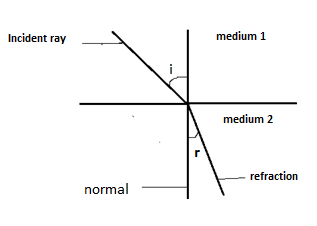Question
Question: What is the relation between angle of incidence and angle of refraction in the glass?...
What is the relation between angle of incidence and angle of refraction in the glass?
Solution
We have a law which gives relation of incident ray or incident angle and refracted angle with refractive index. Refractive index gives a relation between two pairs of mediums. It is also known as Snell –Descartes law and law of refraction. Using this law we can deduce Brewster angle also.
Complete answer:
The relation between angle of incidence and the angle of refraction was discovered by Dutch physicist Willard Snell in 1621 and is known as Snell’s law of refraction. This law gives important conclusions about refraction which states that:
1. At the point of incidence, the incident ray and refracted ray are on opposite sides of the normal. These three are in the same phase.
2. For a given pair of medium 1 and medium 2, the ratio of the sine of the angle of incidence to the sine of the angle of refraction is constant.

Mathematically, Snell’s law is given as,
sinrsini= constant=n; for a given pair of medium n is called a refractive index of the second medium with respect to the first medium. This is known as Snell’s law. The change in direction of a light – ray while entering in different media is a different value of refractive index vary with media.
Therefore Snell’s law gives a relation between angle of incidence i and r in glass.
Note:
Bending of refracted rays depends on density of medium. Refracted ray bends towards the normal, when a light ray that is incident ray passes from a rarer medium to denser medium. If refracted ray bends away from the normal then incident ray must have passed from a denser medium to a rarer medium.
Now if i=0 i.e. incident ray incident normally.
Then sinr=0. This implies that refracted rays will also go straight with no deviation.
